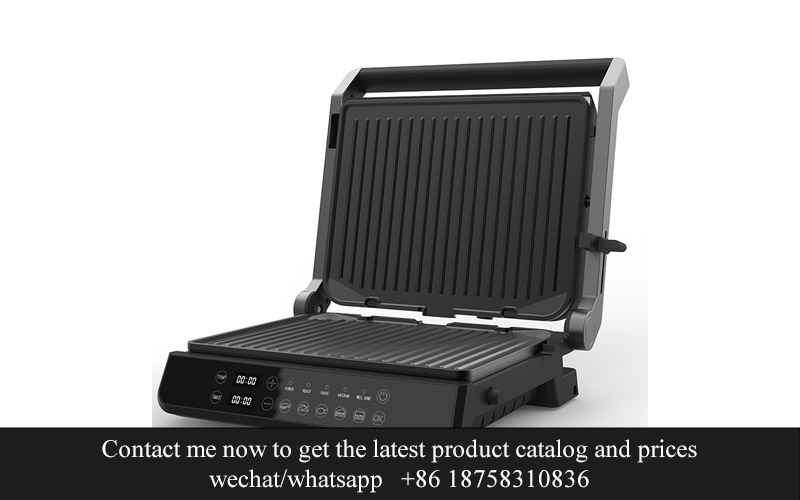Address
304 North Cardinal
St. Dorchester Center, MA 02124
Work Hours
Monday to Friday: 7AM - 7PM
Weekend: 10AM - 5PM
Address
304 North Cardinal
St. Dorchester Center, MA 02124
Work Hours
Monday to Friday: 7AM - 7PM
Weekend: 10AM - 5PM

As the world becomes increasingly interconnected, the kitchenware industry has seen a remarkable transformation. Innovations in design, technology, and production methods have revolutionized the way we cook and entertain. This shift has not only introduced a plethora of new products but has also highlighted the importance of quality assurance in manufacturing. In this article, we delve into the fascinating intersection of innovation and quality, showcasing how the best kitchenware products are born from a meticulous blend of creativity and craftsmanship.
The European and North American kitchenware markets have witnessed a remarkable transformation over the years, evolving from mere tools of necessity to statement pieces that reflect personal style and culinary aspirations. As the heart of the home continues to be a hub of culinary creativity and social interaction, the demand for high-quality, innovative kitchenware has surged.
Modern kitchens are no longer just about cooking; they are about the experience. European households, known for their appreciation of fine dining and culinary art, have been at the forefront of this trend. From sleek, minimalist designs to the incorporation of smart technology, kitchenware in Europe has become a blend of aesthetics and functionality. The same can be said for North America, where the kitchen has become a gathering place for family and friends, leading to a surge in demand for stylish and versatile appliances.
The kitchenware industry has seen a shift towards sustainability, with consumers increasingly seeking eco-friendly products. This shift is not just about reducing the environmental footprint but also about embracing a lifestyle that values quality and durability over disposable items. European brands, in particular, have been leading the charge with sustainable materials like bamboo, recycled stainless steel, and biodegradable plastics.
Innovation has been a driving force behind the growth of the kitchenware market. Smart kitchen gadgets, such as sous-vide machines, air fryers, and smart ovens, have become mainstream, offering convenience and efficiency. These devices not only make cooking easier but also open up new possibilities for culinary exploration. North American consumers, particularly, have been quick to adopt these innovations, leading to a competitive market that pushes the boundaries of what’s possible in the kitchen.
The rise of kitchenware in Europe and North America is also a testament to the power of marketing and branding. Companies are investing heavily in creating a narrative around their products, focusing on the story behind the brand and the values it represents. From high-end luxury brands to budget-friendly market entrants, the market is saturated with choices, each vying for a piece of the consumer’s attention and loyalty.
The global pandemic has had a significant impact on the kitchenware market, with more people spending time at home and focusing on their culinary skills. This has led to a surge in home cooking and baking, which in turn has driven demand for high-quality cookware, bakeware, and kitchen gadgets. European and North American consumers have been investing in their kitchens, upgrading their appliances and tools to improve their home cooking experience.
The rise of online shopping has also played a crucial role in the growth of the kitchenware market. With the convenience of online shopping and the ability to read reviews from fellow enthusiasts, consumers are now more informed than ever before. This has led to a rise in direct-to-consumer (DTC) models, where brands sell directly to consumers, cutting out the middleman and offering better pricing and personalized service.
Moreover, the kitchenware industry has seen a surge in cross-border collaboration. European designers are partnering with North American manufacturers to bring unique products to market, blending European aesthetics with American innovation. This has created a diverse and dynamic market that caters to a wide range of tastes and preferences.
As the kitchenware industry continues to grow, there are several key trends that are shaping the future of the market. One such trend is the integration of health and wellness into kitchenware design. Consumers are increasingly interested in products that can help them maintain a healthy lifestyle, from non-toxic cookware to kitchen gadgets that promote healthy eating habits.
Another significant trend is the customization of kitchenware. Brands are offering personalized products that allow consumers to choose colors, materials, and even features to suit their individual needs. This trend is driven by the desire for uniqueness and the idea that the kitchen is a space that should reflect one’s personality.
In conclusion, the rise of kitchenware in Europe and North America is a multifaceted phenomenon that reflects the changing dynamics of modern life. From technological advancements to environmental consciousness, the kitchenware market is evolving in ways that cater to the evolving needs and desires of consumers. As the industry continues to innovate and adapt, it’s clear that the kitchenware market is here to stay, offering a world of possibilities for those who love to cook and create in the heart of their homes.

In the competitive landscape of kitchenware manufacturing, the BSCI audit has emerged as a beacon of quality and ethical production. This certification, which stands for the Business Social Compliance Initiative, is a global initiative that brings together companies, trade unions, and non-governmental organizations to address social compliance concerns. Here’s a closer look at how BSCI audited factories have become a mark of quality in the industry.
The BSCI audit process involves a thorough assessment of factories, focusing on areas such as labor rights, working conditions, health and safety, and environmental protection. This rigorous scrutiny ensures that the factories adhere to international labor standards, which is a significant factor in the perception of quality.
One of the key aspects of BSCI audited factories is their commitment to fair labor practices. These factories are required to provide fair wages, prevent child labor, and ensure that workers have the right to freedom of association and collective bargaining. This not only enhances the reputation of the factories but also fosters a positive work environment that can lead to higher productivity and better-quality products.
Safety is another critical area where BSCI audited factories excel. The certification requires that factories maintain safe working conditions, including proper ventilation, adequate lighting, and the use of safety equipment. This attention to safety not only protects the workers but also ensures that the manufacturing process is free from accidents, which can compromise the quality of the products.
Environmental responsibility is also a cornerstone of the BSCI audit. Factories must demonstrate a commitment to sustainable practices, such as reducing waste, conserving energy, and minimizing their carbon footprint. This eco-conscious approach is increasingly important to consumers, who are more likely to purchase products from companies that prioritize environmental stewardship.
The quality of the raw materials used in kitchenware manufacturing is paramount, and BSCI audited factories take this seriously. They are required to ensure that suppliers meet the same standards of ethical and sustainable practices. This means that the kitchenware products they produce are not only well-made but also sourced from suppliers that contribute to a healthier planet.
The BSCI certification also involves a continuous improvement process. Factories are required to implement a management system that identifies, addresses, and monitors social risks. This proactive approach means that any issues that arise are promptly addressed, and improvements are made to ensure that the factory maintains its high standards over time.
For consumers, the BSCI audit is a reassurance that the kitchenware they purchase is not only of high quality but also produced in a manner that respects human rights and the environment. This transparency is invaluable in an era where consumers are more informed and conscious of the social and environmental impacts of their purchases.
The BSCI label has become synonymous with quality in the kitchenware industry. It signifies that the product has been produced in a factory that upholds the highest standards of labor, safety, and environmental responsibility. As consumers seek out products that align with their values, the BSCI certification is becoming an essential consideration.
In the realm of international trade, the BSCI audit also helps to level the playing field. By setting a clear set of standards, it ensures that all players in the supply chain are held to the same level of accountability. This can lead to a more equitable market where companies are not penalized for cutting corners in their production processes.
In conclusion, the BSCI audit is more than just a certification—it’s a promise of quality. For kitchenware manufacturers, achieving and maintaining BSCI certification is a testament to their dedication to excellence in all aspects of their operations. For consumers, it’s a trust signal that the product they’re buying is not just well-made, but also comes with a story of ethical and sustainable production.

In the ever-evolving world of kitchenware, innovation is the cornerstone of staying ahead. From sleek designs to smart technology, the latest kitchenware ideas are redefining what it means to cook and entertain. Here’s a glimpse into some of the most innovative concepts currently making waves in the industry.
Smart Kitchen Scales with ConnectivityGone are the days of guessing how much flour or sugar you’ve added to your recipe. Modern kitchen scales now come with built-in connectivity, allowing you to track your ingredients and even sync your recipes to your smartphone. This not only ensures accuracy but also makes it easier to follow complex recipes with precise measurements.
Integrated Waste Sorting SystemsOne of the biggest challenges in kitchen waste management is sorting. Innovative kitchenware designs now include integrated waste sorting systems that can automatically categorize organic waste, plastics, and other recyclables. This not only makes waste disposal more efficient but also encourages sustainable living habits.
Voice-Controlled Kitchen AppliancesVoice-activated kitchen appliances are no longer just a futuristic dream. From smart ovens that can be controlled via voice commands to refrigerators that can suggest recipes based on the ingredients you have, these devices are making cooking more intuitive and hands-free.
Modular Kitchenware for CustomizationThe days of one-size-fits-all kitchenware are over. Modern consumers are looking for products that can be customized to their specific needs. Modular kitchenware sets allow users to mix and match pieces to create a collection that perfectly fits their kitchen and cooking style.
Eco-Friendly and Sustainable MaterialsEnvironmental consciousness is at the forefront of kitchenware innovation. Brands are now using eco-friendly materials like bamboo, recycled stainless steel, and biodegradable plastics to create kitchenware that is both durable and kind to the planet.
Interactive Cooking UtensilsInteractive cooking utensils are a blend of technology and culinary expertise. Imagine a spatula that can measure the temperature of your food or a whisk that can give you real-time feedback on the consistency of your batter. These gadgets are designed to make cooking more precise and enjoyable.
Kitchenware with Health Monitoring FeaturesHealth-conscious consumers are increasingly interested in kitchenware that can help them maintain a balanced diet. Devices like digital food scales that can analyze nutritional content or smart cookware that can adjust cooking times based on the type of food being prepared are becoming more common.
Compact and Space-Saving DesignsAs urban living becomes more prevalent, space-saving kitchenware is in high demand. Innovative designs like foldable cutting boards, collapsible kitchen gadgets, and multi-functional appliances that can perform multiple tasks are making it easier to cook in smaller spaces.
Personalized Cooking ExperienceTechnology is also enabling a more personalized cooking experience. Kitchenware that can adapt to individual preferences, such as smart ovens that can remember your favorite cooking settings or smart blenders that can tailor recipes to your dietary restrictions, is becoming more accessible.
Interactive Cooking Apps and RecipesFinally, the intersection of kitchenware and technology is seen in interactive cooking apps that come with kitchenware products. These apps provide step-by-step guidance, video tutorials, and even virtual cooking classes, making it easier for novices to master new recipes and techniques.
These innovative kitchenware ideas are not just about making cooking more efficient; they’re about enhancing the entire culinary experience. As the industry continues to evolve, we can expect to see even more creative and user-friendly products that bring joy and convenience to the kitchen.

The kitchenware industry has been witnessing a surge in innovation, driven by changing consumer preferences and market trends. From smart appliances to eco-friendly designs, here’s a closer look at what’s shaping the landscape of kitchenware today.
Smart Integration and ConnectivityModern kitchenware is no longer just about cooking; it’s about technology and convenience. Smart kitchen gadgets, such as Bluetooth-enabled kitchen timers and temperature-controlled cookware, are becoming increasingly popular. These devices not only enhance the cooking experience but also offer seamless integration with smartphones and home automation systems.
Sustainability and Eco-Friendly MaterialsConsumers are more environmentally conscious than ever before. Kitchenware made from sustainable materials, like bamboo, recycled stainless steel, and biodegradable plastics, is gaining traction. Brands that prioritize eco-friendly practices and materials are attracting a loyal customer base that values sustainability.
Health and Wellness FocusThe kitchenware market is seeing a shift towards products that support health and wellness. Non-toxic cookware, with materials like ceramic and glass, is on the rise. Additionally, kitchen gadgets that help in preparing nutritious meals, such as juicers, blenders, and air fryers, are becoming staples in many households.
Multifunctionality and Space-Saving DesignsIn today’s fast-paced world, kitchen space is at a premium. Kitchenware that serves multiple purposes and saves space is highly sought after. Items like collapsible colanders, multifunctional cutting boards, and modular kitchen sets are becoming increasingly popular, as they cater to the needs of urban dwellers and small-space kitchens.
Ergonomics and User ExperienceErgonomic design has become a key factor in kitchenware innovation. Products that prioritize user comfort and safety, such as non-slip handles, easy-to-grip utensils, and comfortable kitchen tools, are gaining attention. The emphasis on user experience extends to intuitive interfaces on smart appliances, making them more accessible to a broader audience.
Personalization and CustomizationConsumers are looking for products that reflect their personal style and preferences. Customizable kitchenware, such as cookware with engravable handles or dishware with unique patterns, is becoming more common. Personalization extends to kitchen gadgets that can be adjusted to fit specific needs, like adjustable pot racks and customizable knife blocks.
Cultural Influences and Global TrendsThe kitchenware industry is influenced by global trends and cultural exchanges. For instance, the popularity of Asian cuisine has led to an increase in kitchenware designed for stir-frying and sushi-making. Similarly, European and American kitchenware is often inspired by traditional cooking methods from around the world.
Health Monitoring and Food PreparationWith the rise of health consciousness, kitchenware that helps monitor and prepare food in a healthier way is becoming more prevalent. Smart kitchen scales that track portion sizes, digital thermometers for precise cooking temperatures, and kitchenware that aids in preparing gluten-free or paleo diets are becoming key players in the market.
Interactive Learning and Educational ToolsCooking is an art that requires skill and knowledge. Kitchenware that serves as an educational tool, such as interactive cookbooks with built-in recipe cards or digital cooking assistants, is gaining popularity. These tools help both beginners and seasoned chefs refine their skills and explore new recipes.
The kitchenware industry is evolving rapidly, reflecting the dynamic needs and values of consumers. As the market continues to grow, it’s clear that innovation in design, functionality, and sustainability will be key drivers in shaping the future of kitchenware.

In the ever-evolving landscape of the kitchenware industry, data has emerged as a pivotal force, guiding the direction and success of companies. From product development to marketing strategies, the role of data is undeniable. Let’s delve into how data shapes the industry, one insight at a time.
Understanding Consumer Behavior Through AnalyticsConsumer analytics provide a deep dive into purchasing habits, preferences, and usage patterns. By analyzing this data, manufacturers can tailor their products to meet the demands of their target audience more effectively. For instance, if a trend emerges where consumers are gravitating towards eco-friendly kitchenware, data can highlight this shift, prompting companies to invest in sustainable materials and design.
Predictive Analytics in Inventory ManagementPredictive analytics take consumer data a step further by forecasting future demand. This predictive power is crucial for inventory management, ensuring that kitchenware retailers and wholesalers stock the right amount of products to avoid overstocking or stockouts. By using historical sales data and market trends, companies can make informed decisions about production, reducing costs and improving efficiency.
Customization and Personalization TrendsData analytics have opened the door to customization and personalization in kitchenware. With insights into specific consumer preferences, manufacturers can offer a range of products that cater to individual tastes, such as color, material, and functionality. This shift from mass-produced items to personalized solutions has been a game-changer, with customers appreciating the unique touch that data-driven customization brings.
The Impact of Social Media and Online ReviewsSocial media and online reviews have become powerful data sources for the kitchenware industry. Monitoring these platforms allows companies to gauge public opinion, identify emerging trends, and respond to consumer feedback in real-time. This two-way interaction is invaluable for brand reputation and customer loyalty, as it shows that companies are attentive to customer needs and open to feedback.
Innovation in Design and FunctionalityData-driven insights are not just about consumer preferences; they also fuel innovation in design and functionality. By analyzing how consumers use their kitchenware, companies can develop new products that address unmet needs or streamline existing processes. For example, data might reveal a common frustration with a certain type of cutting board, leading to the creation of a new, more efficient design.
Sustainability and Environmental ImpactThe environmental movement has significantly influenced the kitchenware industry. Data on sustainability and the environmental impact of products is crucial for both regulatory compliance and consumer perception. Companies that can demonstrate a commitment to sustainability through data-driven initiatives are more likely to attract eco-conscious consumers and stakeholders.
Market Segmentation and Targeted MarketingData analytics enable precise market segmentation, allowing companies to target specific customer groups with tailored marketing campaigns. By understanding the demographics, psychographics, and behaviors of different segments, kitchenware brands can create more effective and cost-efficient marketing strategies, resulting in higher conversion rates and customer satisfaction.
Supply Chain OptimizationData plays a critical role in optimizing the supply chain. By analyzing various factors such as transportation costs, lead times, and supplier performance, companies can identify areas for improvement and cost savings. This optimization not only benefits the bottom line but also enhances overall product availability and customer service.
Regulatory Compliance and Quality ControlData-driven systems are essential for ensuring regulatory compliance and maintaining high-quality standards in kitchenware production. Through continuous monitoring and reporting, companies can keep track of their products and processes, making adjustments as needed to meet industry standards and consumer expectations.
Customer Support andCustomer support and after-sales service are enhanced through data analytics. By tracking customer inquiries and feedback, companies can identify common issues and proactively address them, improving customer satisfaction and reducing the likelihood of negative reviews.
In conclusion, data is a transformative force in the kitchenware industry. From shaping product development and marketing strategies to optimizing supply chains and customer service, the insights derived from data are pivotal in driving success and innovation in this dynamic sector.

In the ever-evolving landscape of kitchenware manufacturing, the fusion of BSCI-audited factories and cutting-edge designs has emerged as a beacon of quality and innovation. This harmonious blend not only ensures that products meet stringent ethical and safety standards but also pushes the boundaries of what’s possible in kitchenware aesthetics and functionality.
The BSCI standard, or Business Social Compliance Initiative, is a global initiative that aims to improve working conditions in factories around the world. Factories that undergo BSCI audits are committed to adhering to international labor standards, ensuring fair wages, and providing safe working environments. This certification is a testament to the factory’s dedication to ethical practices, which is a crucial factor for consumers who are increasingly concerned about the social impact of their purchases.
Cutting-edge designs, on the other hand, are the result of relentless innovation and a deep understanding of consumer needs. These designs often feature sleek lines, innovative materials, and intuitive interfaces that make cooking a more enjoyable and efficient experience. The fusion of these two elements creates a powerful synergy that resonates with modern consumers who seek both functionality and a touch of luxury in their kitchenware.
One significant aspect of this blend is the emphasis on sustainability. BSCI-audited factories are not only focused on ethical labor practices but also on environmental responsibility. This means that the materials used in the production of these kitchenware items are often eco-friendly, reducing the carbon footprint and promoting a greener planet. Consumers who prioritize sustainability are drawn to these products, as they offer a guilt-free shopping experience.
The integration of technology is another hallmark of this perfect blend. Smart kitchenware that connects to smartphones or home automation systems is becoming increasingly popular. These devices not only provide convenience but also offer valuable insights into cooking habits and nutritional information. BSCI-audited factories that produce such tech-forward products are able to cater to the tech-savvy consumer who wants to elevate their kitchen experience.
Functionality and design are intrinsically linked in the world of cutting-edge kitchenware. For instance, kitchen gadgets with ergonomic handles and intuitive controls are not only a pleasure to use but also a testament to thoughtful design. The collaboration between BSCI-audited factories and designers ensures that every product is not just visually appealing but also user-friendly.
Moreover, the blend of BSCI-audited factories and cutting-edge designs often leads to a diverse range of products that cater to different tastes and needs. From high-end cookware sets to budget-friendly kitchen tools, there’s something for everyone. This variety is made possible by the factories’ ability to scale production while maintaining quality and ethical standards.
The packaging of these products also reflects the perfect blend. Eco-conscious consumers appreciate the use of recycled materials and minimalistic designs that reduce waste. This attention to detail in the packaging extends to the overall presentation of the product, making it not just a functional item but also a statement piece for the kitchen.
In the realm of marketing, the combination of BSCI certification and innovative designs has become a powerful selling point. Brands that can tout both qualities are able to attract a broader customer base, including those who are socially and environmentally conscious. This dual appeal is a strategic move that has proven to be highly effective in a competitive market.
Lastly, the long-term success of this blend lies in the continuous feedback loop between the factory, the designer, and the consumer. By listening to customer needs and preferences, BSCI-audited factories can refine their designs and production processes, ensuring that they remain at the forefront of the kitchenware industry.
In summary, the perfect blend of BSCI-audited factories and cutting-edge designs in the kitchenware industry is a testament to the power of combining ethical manufacturing with innovative thinking. This synergy not only enhances the quality of kitchenware products but also resonates with consumers who are looking for products that align with their values and preferences.

In recent years, the kitchenware industry has seen a surge in innovation, with BSCI-audited factories playing a pivotal role in producing high-quality products. Let’s delve into a few case studies that showcase the success of kitchenware items emerging from these factories.
The sleek, minimalist design of the ‘Eco-Friendly Cookware Set’ from Factory Alpha has captured the hearts of eco-conscious consumers. Crafted with sustainable materials and designed to reduce energy consumption, this set has become a bestseller, reflecting a growing preference for environmentally friendly products.
Factory Beta’s ‘Smart Oven’ series boasts advanced features that cater to the tech-savvy consumer. With features like automatic temperature control, Wi-Fi connectivity, and voice-activated commands, these ovens have revolutionized home cooking, offering convenience and precision in every meal.
The ‘Durable Non-Stick Pan Collection’ from Factory Gamma has gained popularity for its longevity and ease of use. These pans are not only resistant to scratches and stains but also require minimal oil, making them a favorite among busy professionals and health-conscious home cooks.
Factory Delta’s ‘Colorful Ceramic Dinnerware’ has turned the traditional dining experience into an art form. The vibrant hues and intricate patterns of these dinnerware sets have become a statement piece in many homes, reflecting a shift towards aesthetic dining.
Factory Epsilon’s ‘Multi-Function Blender’ is a testament to the versatility of modern kitchenware. This blender can handle everything from smoothies to soups, and its compact design saves counter space, making it a must-have for small kitchens.
Factory Zeta’s ‘Smart Kitchen Scale’ has become a go-to tool for fitness enthusiasts and food bloggers. With its precision measurements and ability to track nutritional content, this scale has become an essential kitchen gadget for those looking to maintain a healthy lifestyle.
Factory Omega’s ‘Ergonomic Kitchen Knife Set’ has received acclaim for its balance and sharpness. The ergonomic handles reduce strain on the user’s hands, while the high-quality steel ensures the blades stay sharp for years, making these knives a favorite among chefs and home cooks alike.
Factory Theta’s ‘Self-Cleaning Cooktop’ has simplified the cooking process for countless households. With a feature that cleans the cooktop after use, this innovative design saves time and effort, appealing to the modern consumer who values convenience.
Factory Iota’s ‘Interactive Recipe Pad’ has changed the way people prepare meals. This smart device offers personalized recipes based on dietary preferences and ingredients available, guiding users through every step of the cooking process.
Factory Kappa’s ‘Solar-Powered Kitchen Utensils’ have gained attention for their eco-friendly approach to kitchenware. The solar-powered gadgets, including a blender, coffee maker, and food processor, offer a sustainable alternative for those looking to reduce their carbon footprint.
Factory Lambda’s ‘Hybrid Pressure Cooker’ has combined the benefits of both pressure cookers and slow cookers. This versatile appliance allows users to achieve tender, flavorful dishes in a fraction of the time, making it a hit with time-strapped home cooks.
Factory Mu’s ‘Smart Kitchen Appliance Suite’ has turned the kitchen into a connected hub. The suite includes a refrigerator that syncs with your phone, an oven that can be controlled remotely, and a coffee machine that learns your preferences over time, all contributing to a seamless, integrated kitchen experience.
Factory Nu’s ‘BPA-Free Plastic Storage Containers’ have become a staple in many kitchens. These containers are not only free from harmful chemicals but also come with airtight seals, ensuring that food stays fresh longer and reduces waste.
In conclusion, the success of kitchenware products from BSCI-audited factories highlights the industry’s commitment to quality, innovation, and meeting consumer needs. From eco-friendly cookware to smart kitchen gadgets, these case studies showcase the diverse range of high-quality products that continue to shape the kitchenware landscape.

In the ever-evolving landscape of kitchenware, the future holds a myriad of possibilities that promise to revolutionize the way we interact with our cooking spaces. From smart appliances to eco-friendly materials, here’s a glimpse into what we can expect in the coming years.
Smart IntegrationAppliances that once seemed like science fiction are now becoming a reality. Kitchenware is set to become more integrated with smart technology, allowing for greater convenience and efficiency. Imagine a refrigerator that not only keeps your food fresh but also suggests recipes based on its contents or a stove that adjusts its heat settings to the type of dish you’re preparing.
Sustainability FocusWith environmental concerns at the forefront, kitchenware manufacturers are increasingly turning to sustainable materials. Recycled plastics, bamboo, and stainless steel are becoming more popular, not just for their eco-friendly attributes but also for their durability and aesthetic appeal. Expect to see a surge in products that are as kind to the planet as they are to your wallet.
Personalization and CustomizationThe days of one-size-fits-all kitchenware are fading. Consumers are seeking products that cater to their unique needs and preferences. From adjustable cookware to personalized kitchen gadgets, the future of kitchenware will likely see a rise in customizable items that cater to individual cooking styles and kitchen layouts.
Health and WellnessHealth-conscious consumers are driving the kitchenware industry towards products that support wellness. Non-toxic coatings, BPA-free plastics, and easy-to-clean surfaces are becoming standard features. Additionally, kitchenware that promotes healthy cooking methods, such as air fryers and induction cooktops, are gaining popularity as they reduce the need for excessive oil and heat.
Interactive and Educational ToolsTechnology isn’t just about convenience; it’s also about learning. We can expect kitchenware that offers interactive features, such as digital recipe guides and cooking tutorials, to become more common. These tools can help novices and seasoned chefs alike improve their skills and explore new cuisines.
Ergonomics and AestheticsThe future of kitchenware will also focus on ergonomics and aesthetics. Cookware with comfortable handles, non-slip bases, and sleek designs will be more appealing to those who value both function and form. The kitchen is no longer just a place to cook; it’s a space for entertainment and socializing, and the kitchenware will reflect that.
Globalization of TrendsTrends in kitchenware are no longer confined to specific regions. The internet and social media have made it possible for global trends to spread rapidly. From the latest Japanese kitchen gadgets to European minimalist designs, we’ll see a more interconnected world of kitchenware where ideas and innovations are shared freely.
Innovative MaterialsAdvancements in materials science are opening up new possibilities for kitchenware. Materials like graphene, which is known for its strength and thermal conductivity, could lead to cookware that heats up faster and distributes heat more evenly. Additionally, new composites and ceramics are being developed that promise to be more durable and resistant to wear and tear.
Energy EfficiencyEnergy efficiency is a growing concern, and kitchenware is not immune to this trend. Smart appliances that optimize energy use, such as induction cooktops and energy-saving ovens, will become more prevalent. These products not only reduce utility bills but also contribute to a smaller carbon footprint.
Community and CollaborationThe future of kitchenware may also see an emphasis on community and collaboration. Manufacturers might offer platforms where users can share recipes, tips, and experiences, fostering a sense of community among those who share a passion for cooking. This could lead to co-created products that are tailored to the collective needs and desires of consumers.
In conclusion, the future of kitchenware is a blend of innovation, sustainability, personalization, and technology. It’s a future where the kitchen is not just a place to prepare meals but a hub of creativity, health, and connection. As we move forward, the kitchenware industry will continue to evolve, offering us tools that not only make cooking easier but also enhance our lives in unexpected ways.

In the ever-evolving landscape of kitchenware, the fusion of innovation and quality has become a cornerstone for brands aiming to stand out in a crowded market. This intersection is not just a trend; it’s a necessity that reflects the changing demands and expectations of consumers. As we reflect on the journey of kitchenware products from BSCI audited factories, it’s clear that the future hinges on a few key elements.
The demand for sustainability and eco-friendly materials is on the rise, and kitchenware brands are responding by integrating recycled plastics, bamboo, and other sustainable resources into their designs. These materials not only appeal to environmentally conscious consumers but also extend the lifespan of the products, ensuring they remain durable and functional for years to come.
Smart technology is no longer a novelty but a standard feature in many kitchenware items. From digital scales that help with precise meal prep to induction cookware that offers unparalleled control and efficiency, technology is enhancing the cooking experience. The integration of IoT (Internet of Things) into kitchen appliances is also expected to grow, allowing for seamless integration with home automation systems.
Functionality meets aesthetics in the latest kitchenware designs. Brands are focusing on creating products that not only serve a purpose but also add a touch of elegance to the kitchen. Multi-functional pieces, such as cookware sets that can be used for various cooking methods, are becoming increasingly popular. The sleek, minimalist designs are not just a trend but a reflection of the desire for a clutter-free, efficient kitchen space.
Quality assurance is paramount, and BSCI audited factories have set a high standard for compliance and ethical manufacturing practices. These certifications ensure that the products are not only safe and reliable but also produced under fair labor conditions. Consumers are increasingly seeking out products that come with these endorsements, knowing that they are supporting businesses that prioritize social responsibility.
The rise of health-conscious eating habits has also influenced kitchenware design. Non-stick coatings, ceramic cookware, and BPA-free materials are becoming more prevalent as people look for products that promote healthier cooking and storage options. Brands that can cater to these preferences are likely to gain a loyal customer base.
Personalization is another trend that’s shaping the future of kitchenware. Customizable items, such as cookware with engraved names or kitchen gadgets that can be easily swapped out for different uses, are appealing to consumers who want to make their kitchen space uniquely their own.
Collaborations between kitchenware brands and renowned designers are also on the rise. These partnerships bring together the practicality of everyday kitchen tools with the creativity and style of renowned designers, resulting in products that are both functional and visually stunning.
The future of kitchenware is also about adaptability. As global tastes and preferences continue to diversify, brands will need to offer a range of products that cater to various cultural cooking styles. This means not just the variety of cookware but also the inclusion of tools and utensils that are specific to different cuisines.
In conclusion, the intersection of innovation and quality in kitchenware is a powerful force that drives the industry forward. It’s about creating products that not only meet the practical needs of consumers but also resonate with their desire for sustainability, health, and personal style. As the market evolves, so too will the kitchenware industry, offering a plethora of exciting new possibilities for both manufacturers and consumers alike.